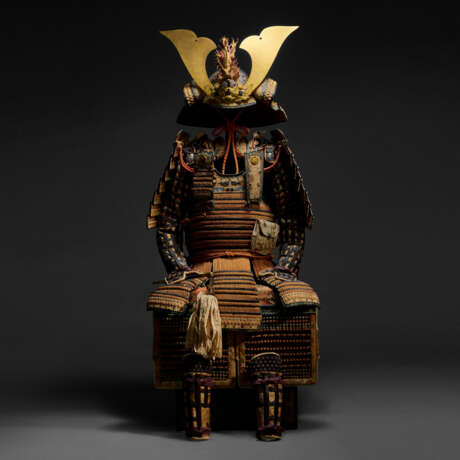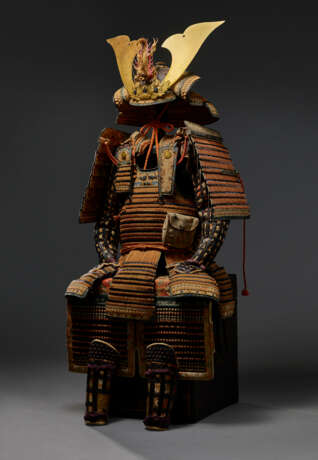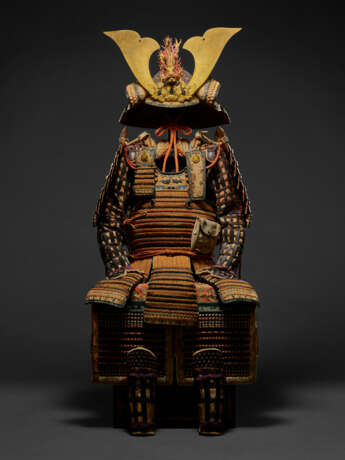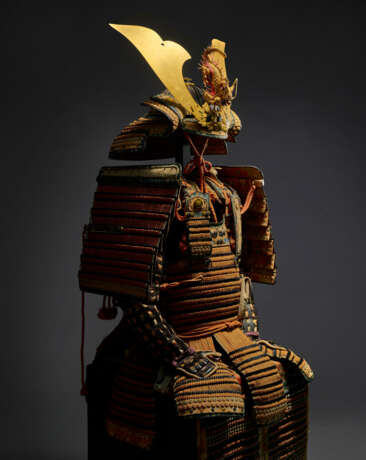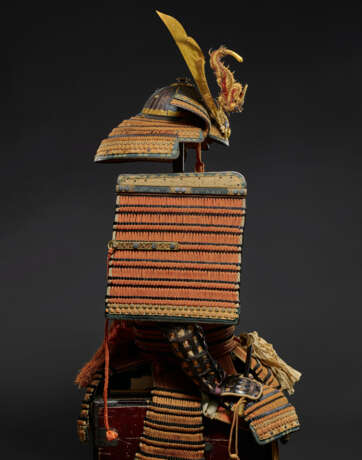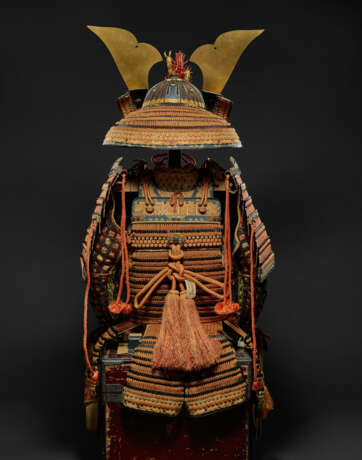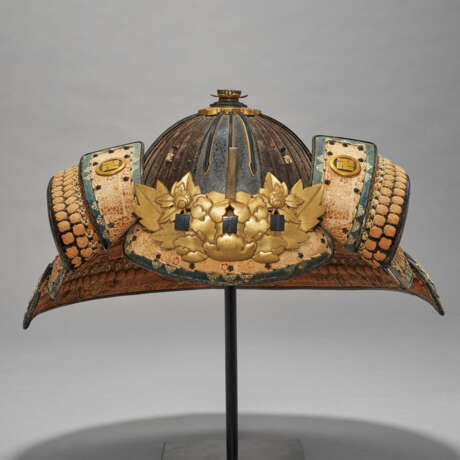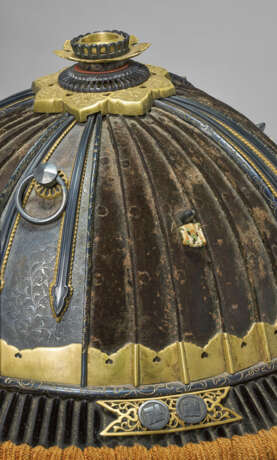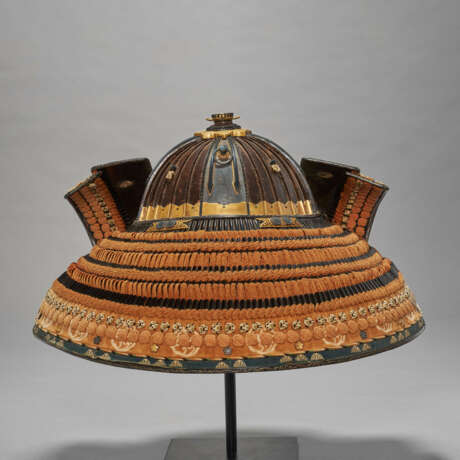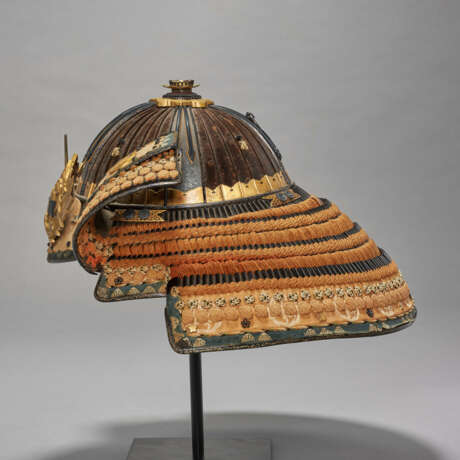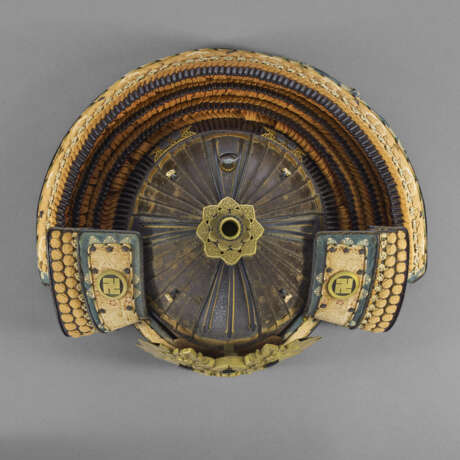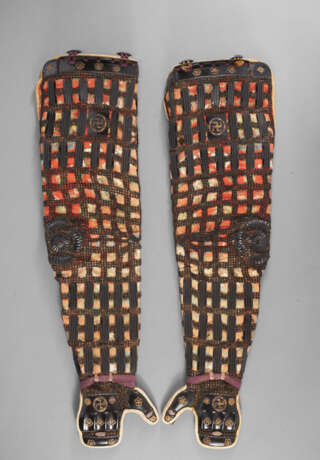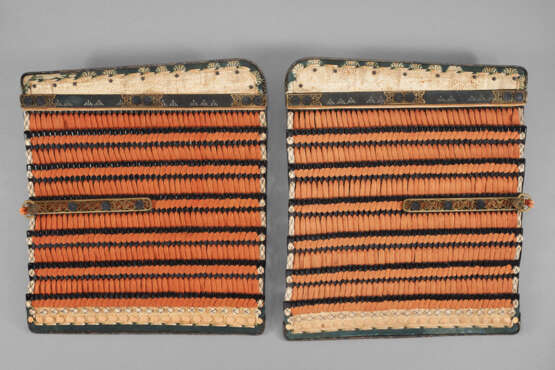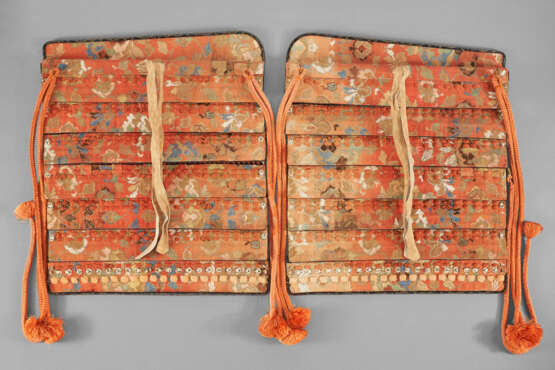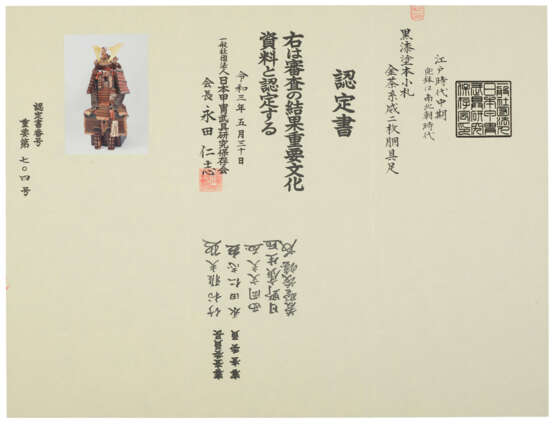ID 813604
Lot 111 | AN ORANGE-LACED HONKOZANE DAIMYO DOMARU GUSOKU (ARMOR)
Valeur estimée
$ 80 000 – 120 000
EDO PERIOD (18TH CENTURY), HELMET BOWL: NANBOKUCHO PERIOD (14TH CENTURY)
Helmet [kabuto]:
The thirty-two-plates Nanbokucho period hoshi bachi kabuto (“star bowl,” alluding to the protruding rivets), with elaborate gilt, shakudo, shibuichi and copper hachimanza (decorative fixture at the central aperture) of eight-tier, with shakudo shinodare (four sets of pendant arrow shaped decorative pieces) with gilt and silver kokizamiza set on silver plates engraved with scrolling arabesque on a nanako (fish-roe) ground with shakudo rim incised in gilt, with the unusual feature of having hibiki-no-ana (four holes in the sides of a helmet for loop of silk lacing) and shitenno-byo (a single standing rivet placed above the holes), with gilt kuwagata-dai (fixture for two gilt horns) in the form of peony flowers applied with three shakudo rivets with characters 'eight', 'sky' and 'spring', a pair of exceptionally large kuwagata (gilt horns) and the maedate (fore-crest) of gilt lacquered wood dragon with gilt eyes, shakudo fukurin (edging) engraved with scrolling in gilt
Neck guard [shikoro]:
The wide and gently curving four-tier kasa-jikoro ("straw hat," or "umbrella"-shape neck guard) of orange lacing kebikiodoshi (close-lacing) of lacquered iron honkozane (small individual scales laced together), hishinui no ita clad with leather and with gold and silver decorative rivets in the form of cherry blossom, the interior of neck guard lined with multicolored silk brocade, the large double fukigaeshi (turn-backs) clad with leather with gilt maru hidarimanji-mon (family crest of circled manji character), shakudo fukurin (edging) engraved with scrolling in gilt
Cuirass [do]:
The black lacquered iron honkozane domaru (cuirass) of orange lacing kebikiodoshi (close-lacing), the western style erimawashi (brigandine neck and shoulders mantle) with kesho chirimen (elaborate silk crepe), the munaita (breast portion) clad with leather and applied with two facing silver dragons, shoji no ita with shakudo fukurin (edging) engraved with scrolling in gilt, with sendan no ita and kyubi no ita with gilt maru hidarimanji mon (family crest of circled manji character), the large fixture of agemaki-no-kan (ring to hold a decorative bow) on reverse side pierced with scrolling arabesque, the shakudo kohaze mounts elaborately engraved in gilt, the seven kusazuri (skirt) in five tiers of honkozane of lacquered plates and the hishinui no ita clad with leather and with gold and silver decorative rivets in the form of cherry blossom, the interior of skirt lined with multicolored silk brocade, a silk brocade pouch at the waist
Sleeves and shoulder guards [kote and sode]:
The lacquered iron koshinokote (sleeves), the hand covers applied with small gilt maru hidarimanji mon (family crest of circled manji character) and lined with leather, O-sode (large shoulder guards) of black lacquered honkozane with orange lacing applied with shakudo fukurin (edging) engraved with scrolling in gilt, the gilt hassokanamono and kogaikanamono (decorative metal pierced strips) applied with shibuichi maru hidarimanji-mon (family crest of circled manji character), reverse side lined with multicolored silk brocade
Thigh protector and lower leg guards [haidate and sune-ate]:
The lacquered leather itahaidate (thigh guard) of five tier of close-linked rectangular plates, the russet iron nanahon shinosuneate (seven-splint lower leg guards)
Accessories:
The saihai (paper signal baton), wood armor storage box
Accompanied by a certificate of registration as a Juyo bunka shiryo (Important cultural material) no. 704 issued by the Nihon Katchu Bugu Kenkyu Hozon Kai (Japanese Armor Preservation Society), dated 2021.5.30
Provenance
Hachisuka Muneshige (1721-1780), the eighth generation daimyo of Awa Tokushima clan, Tokushima Prefecture
Literature
Hachisukake no meiho to daimyo bijutsu no sekai (Treasures from Hachisuka Family and the world of Daimyo art), (Tokushima City: Tokushima Castle Museum, 2007). exh. cat. no. 38.
Exhibited
"Hachisukake no meiho to daimyo bijutsu no sekai" (Treasures from Hachisuka Family and the world of Daimyo art), Tokushima Castle Museum, 20 July-26 August 2007
Special Notice
Prospective purchasers are advised that several countries prohibit the importation of property containing materials from endangered species, including but not limited to coral, ivory and tortoiseshell. Accordingly, prospective purchasers should familiarize themselves with relevant customs regulations prior to bidding if they intend to import this lot into another country.
| Époque historique: | Époque d'Edo |
|---|---|
| Lieu d'origine: | Asie de l'Est, Japon |
| Catégorie maison de vente aux enchères: | Armure |
| Époque historique: | Époque d'Edo |
|---|---|
| Lieu d'origine: | Asie de l'Est, Japon |
| Catégorie maison de vente aux enchères: | Armure |
| Adresse de l'enchère |
CHRISTIE'S 20 Rockefeller Plaza 10020 New York Etats-Unis | ||||||||||||||
|---|---|---|---|---|---|---|---|---|---|---|---|---|---|---|---|
| Aperçu |
| ||||||||||||||
| Téléphone | +1 212 636 2000 | ||||||||||||||
| Fax | +1 212 636 4930 | ||||||||||||||
| Conditions d'utilisation | Conditions d'utilisation | ||||||||||||||
| transport |
Service postal Service de messagerie ramassage par vous-même | ||||||||||||||
| Modes de paiement |
Virement bancaire | ||||||||||||||
| Heures d'ouverture | Heures d'ouverture
|
